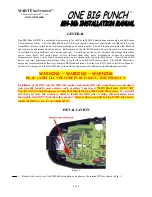
5 Assembly and Operation
22
•
When switching to
Δ
operation of the electric motor
the solenoid valve (- Y1 - Fig. 4) is supplied with
power which interrupts the connection between
pressure reservoir and suction regulator.
•
The piston chamber of the regulator is relieved by
the throttle valve (- 2.4 - Fig. 4) and the spring
pushes the piston down. As a result of the intake
vacuum, the non-return piston moves in the same
direction. The suction regulator is opened by the
intake vacuum. Now the intake path is open.
•
The minimum pressure and non-return valve
(- 13 - Fig. 4) opens at a reservoir pressure of
65 PSI.
•
The compressed air feed to the distribution system
begins.
•
Automatic Operation (OPEN/CLOSE operation)
•
If the pressure at the system pressure sensor
(- 19 - Fig. 4) reaches the upper switching point set,
power is cut to solenoid valve (- Y1 - Fig. 4).
•
The piston chamber (- 2 - Fig. 4) is vented and the
intake path is closed.
•
The pressure reservoir (- 6 - Fig. 4) is relieved by
the throttle valve (- 2.4 - Fig. 4) and the non-return
valve (- 2.5 - Fig. 4).
•
The compressor is now running in OFF-LOAD.
•
If the system pressure does not sink to the lower
switching point within 90 seconds (adjustable) then
the system is shut down.
•
If the lower switching point is reached before 90
seconds expire, voltage is applied again to the
solenoid valve (- Y1 - Fig. 4).
•
The system changes back to ON-LOAD.
Switching off the System
•
After pressing the STOP button
on the operating
panel (see page 34) solenoid valve (- Y1 - Fig. 4) is
de-energized.
•
Suction regulator (- 2 - Fig. 4) is closed and the
pressure reservoir (- 6 - Fig. 4) is relieved.
•
After 30 seconds the electric motor (- 3 - Fig. 4) is
switched off.
5.5.2
Regulator L23RS-L29RS
System Idle
•
See 5.5.1 System Idle
Starting the System
•
The motor control accelerates the electric motor
(- 3 - Fig. 4) to the maximum rotational speed.
•
At the beginning of the acceleration phase the
suction regulator is open.
•
In a few seconds a pressure of approximately 22 PSI
is created in the demister vessel (- 6 - Fig. 4). This
pressure travels through the open solenoid valve
(- Y1 - Fig. 4) to the regulator
ʼ
s piston chamber
(- 2 - Fig. 4). This pressure is sufficient to close the
regulator.
•
The compressor sucks in a certain volume of air
through the non-return valve (- 2.3 - Fig. 4) to keep
the reservoir pressure up.
•
After reaching the maximum rotational speed the
solenoid valve (- Y1 - Fig. 4) is powered which
interrupts the connection between pressure
reservoir and suction regulator.
•
The piston chamber of the regulator is relieved by
the throttle valve (- 2.4 - Fig. 4) and the spring
pushes the piston down. As a result of the intake
vacuum, the non-return piston moves in the same
direction. The suction regulator is opened by the
intake vacuum. The intake path is open.
•
The minimum pressure non-return valve
(- 13 - Fig. 4) opens at a reservoir pressure of
approximately 65 PSI.
•
The compressed air feed to the distribution system
begins.
Stopping the System:
•
After pressing the STOP button
on the operating
panel of the GD Pilot compressor control, power is
cut to the solenoid valve (- Y1 - Fig. 4) while the
drive motor is running.
•
The suction regulator is closed.
•
The rotational speed is lowered by the motor control
to the minimum value set.
•
The pressure reservoir (- 6 - Fig. 4) is relieved to a
constant pressure of 22PSI.
•
The drive motor (- 3 - Fig. 4) is shut off after
30 seconds.
•
Once the drive motor stops, the remaining reservoir
pressure is blown into the intake channel via the
solenoid valve (- Y1 - Fig. 4) and the throttle valve
(- 2.4 - Fig. 4).
Содержание L23
Страница 2: ......
Страница 61: ...12 Appendix 59 Fig 33 All dimensions in inches ...
Страница 62: ...12 Appendix 60 Fig 34 All dimensions in inches ...
Страница 63: ......
















































